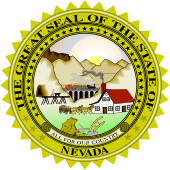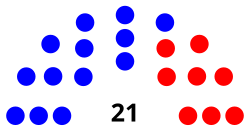Nevada Senate | |
|---|---|
| Nevada Legislature | |
 | |
| Type | |
| Type | |
Term limits | 3 terms (12 years) |
| History | |
New session started | February 6, 2023 |
| Leadership | |
President pro tempore | |
Majority Leader | |
Minority Leader | |
| Structure | |
| Seats | 21 |
 | |
Political groups | Majority
Minority
|
Length of term | 4 years |
| Authority | Article 4, Constitution of Nevada |
| Salary | $146.90/day (first 60 days) per diem (entire session) |
| Elections | |
Last election | November 8, 2022 (11 seats) |
Next election | November 5, 2024 (10 seats) |
| Redistricting | Legislative control |
| Meeting place | |
| State Senate Chamber Legislative Building, Carson City | |
| Website | |
| Home | |
The Nevada Senate is the upper house of the Nevada Legislature, the state legislature of U.S. state of Nevada, the lower house being the Nevada Assembly. It currently (2012–2021) consists of 21 members from single-member districts.[1] In the previous redistricting (2002–2011) there were 19 districts, two of which were multimember. Since 2012, there have been 21 districts, each formed by combining two neighboring state assembly districts. Each state senator represented approximately 128,598 as of the 2010 United States census. Article Four of the Constitution of Nevada sets that state senators serve staggered four-year terms.[2]
In addition, the size of the Senate is set to be no less than one-third and no greater than one-half of the size of the Assembly.[3] Term limits, limiting senators to three 4-year terms (12 years), took effect in 2010. Because of the change in Constitution, seven senators were termed out in 2010, four were termed out in 2012, and one was termed out in 2014. The Senate met at the Nevada State Capitol in Carson City until 1971, when a separate Legislative Building was constructed south of the Capitol. The Legislative Building was expanded in 1997 to its current appearance to accommodate the growing Legislature.
- ^ "Nevada State Senate - 2011 Districts" (PDF). Legislative Counsel Bureau. January 6, 2012.
- ^ "Nevada Constitution". Legislative Counsel Bureau. Retrieved January 1, 2013.
- ^ "Nevada Constitution". Legislative Counsel Bureau. Retrieved January 1, 2013.